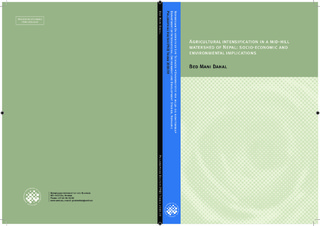| dc.contributor.advisor | Sitaula, Bishal K. | |
| dc.contributor.advisor | Nyborg, Ingrid L. P. | |
| dc.contributor.advisor | Bajracharya, Roshan M. | |
| dc.contributor.advisor | Sharma, Subodh | |
| dc.contributor.author | Dahal, Bed Mani | |
| dc.coverage.spatial | Nepal | nb_NO |
| dc.date.accessioned | 2017-02-23T14:56:02Z | |
| dc.date.available | 2017-02-23T14:56:02Z | |
| dc.date.issued | 2010 | |
| dc.identifier.isbn | 978-82-575-0949-1 | |
| dc.identifier.issn | 1503-1667 | |
| dc.identifier.uri | http://hdl.handle.net/11250/2431959 | |
| dc.description.abstract | Agricultural intensification is unavoidable due to the food requirements of a growing population, market availability and access to agro-products, and limited productive agricultural areas in Nepal. A shift from cultivating cereal crops towards vegetables and other cash crop has evolved through the process of agricultural intensification in the hills of the Himalayan region. With increased market access and road links to urban centres, settled agriculture in Nepal is becoming transformed into intensified cropping, especially in peri- and semi-urban areas.
This study reviewed the historic development of intensification, its evolution and adoption by farmers, and its effects on society and the environment in Ansikhola watershed of Kavre district in Nepal. For the historic and socio-economic aspects, personal interviews, discussion with key farmers, specific case studies, and focus group discussions with different wealth and caste groups where conducted. For the environmental aspects, field erosion plots were established to measure the runoff, soil loss and nutrient losses from agricultural lands. The eroded sediment samples and river water samples were analyzed for major soil nutrients, chemicals, and aquatic macro-invertebrates. The effect of crop intensification on stream water quality is based on the comparison of two mid-hill watersheds with different degrees of intensification. | nb_NO |
| dc.language.iso | eng | nb_NO |
| dc.publisher | Norwegian University of Life Sciences, Ås | nb_NO |
| dc.relation.ispartofseries | PhD Thesis;2010:39 | |
| dc.rights | Attribution-NonCommercial-NoDerivatives 4.0 Internasjonal | * |
| dc.rights.uri | http://creativecommons.org/licenses/by-nc-nd/4.0/deed.no | * |
| dc.subject | Agricultural intensification | nb_NO |
| dc.subject | Socio-economic conditions | nb_NO |
| dc.subject | Food security | nb_NO |
| dc.subject | Soil erosion | nb_NO |
| dc.subject | Water quality | nb_NO |
| dc.subject | Sustainable development | nb_NO |
| dc.subject | Ansikhola | nb_NO |
| dc.title | Agricultural intensification in a mid-hill watershed of Nepal : socio-economic and environmental implications | nb_NO |
| dc.type | Doctoral thesis | nb_NO |
| dc.subject.nsi | VDP::Agriculture and fishery disciplines: 900::Agriculture disciplines: 910 | nb_NO |
| dc.source.pagenumber | 1 b. (flere pag.) | nb_NO |

